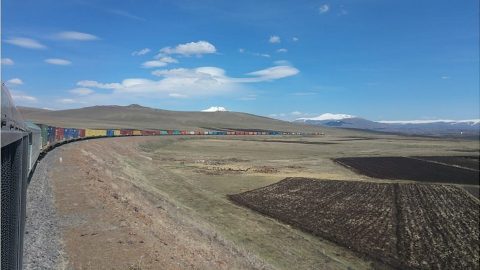UTLC ERA sees further drop of volumes on New Silk Road via Russia

Cargo volumes transported on the New Silk Road via Russia continue to drop. In April, 18,498 TEUs were recorded on rail between Europe and China, a decrease of almost 34 per cent compared to April last year. Although the impact of the war was already visible in April 2022, 27,934 TEUs were still being transported via the Russian route. In March of this year, the volume was 21,034 TEUs.
This is evident from data provided by the Eurasian Rail Alliance Index (ERAI), a tool created by UTLC ERA, the main operator on the route via Kazakhstan, Russia and Belarus. The figures correspond to the volumes they have handled, which should indicate the overall trend. It must be noted that these figures do not always align with other statistics.
According the ERAI index, in the first quarter of this year a total of 59,956 TEUs were transported over the route, almost 54 per cent less than in the first quarter of 2022. The lowest was in February of this year, when over 17,586 TEUs were transported over the route. After a small increase in March, volumes dropped again in April.
Customer perspective
However, Igor Tambaca, founder of logistics service provider Rail Bridge Cargo, a Dutch company active on the New Silk Road has seen a slight increase in transport over the route via Russia in recent months. “The volumes we transport via Russia have increased by about 5 to 6 per cent since the beginning of this year. Because nothing has gone wrong with the transport of freight on the route so far, customers and insurers are getting less concerned.
“In addition, there are now express trains between Xian and Duisburg that have priority over other trains on the borders with Kazakhstan, Belarus and Poland. The transit time is now 11.5 days, which is attractive to customers”, he explains. “You do see that there is less cargo in the entire transport sector due to the economic recession. We notice that too. As a result, we see a strong increase in smaller LCL shipments (less than container load, ed.). This type of cargo has increased by at least 55 per cent in recent months, which is extreme,” he says.
The Middle Corridor grows
At the same time, the Middle Corridor, the alternative to the northern route that runs through Kazakhstan, Azerbaijan and Georgia, saw strong growth at the beginning of this year. In the first quarter of 2023, Kazakhstan Railways transported almost 64 per cent more cargo on the Middle Corridor than last year to and from Kazakhstan, the company reports. Kazakhstan’s exports on this route almost tripled compared to the same period last year.
According to the national railway company, the country transported 433,200 tons on the Middle Corridor between January and March this year, an increase of 63.7 per cent compared to the previous year. According to the company, this is due to the measures taken to improve the capacity of the corridor.
This article was originally published on Nieuwsblad Transport, our Dutch sister publication.




